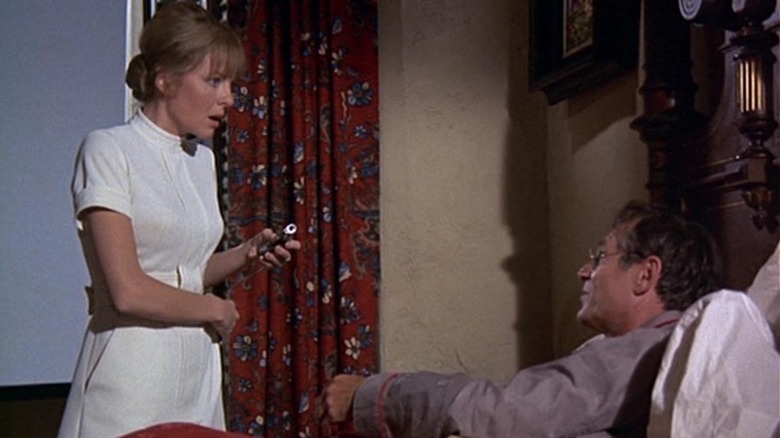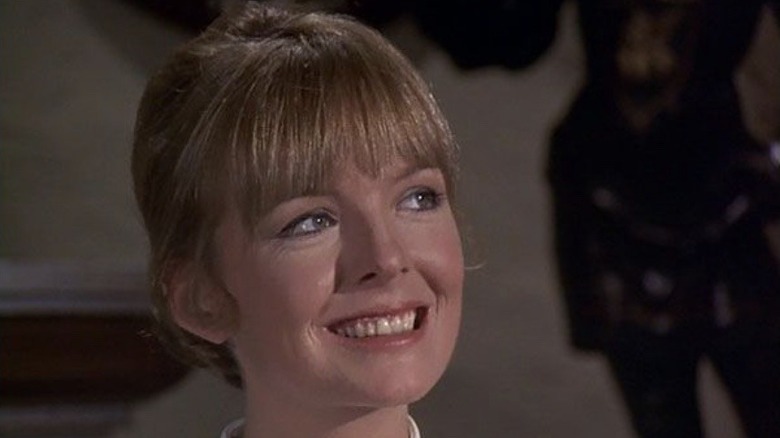Diane Keaton Appeared In Rod Serling's Twilight Zone Follow-Up Before Her Rise To Fame
We may receive a commission on purchases made from links.
Beloved actress Diane Keaton passed away on Saturday, October 11, at 79. Throughout her lifetime, she starred in over 50 movies and appeared in countless TV shows, and one of those early pre-breakout performances came in the NBC series "Night Gallery."
Although the anthology horror show "Night Gallery" was never as popular as creator Rod Serling's previous show, "The Twilight Zone," both shows had a fun knack for highlighting the talents of young, soon-to-be stars. "The Twilight Zone" provided opportunities for young actors like Robert Duvall and Robert Redford to prove themselves to a national audience, and a few years later, "Night Gallery" gave Keaton the same chance.
Keaton, then in her early 20s, starred in the show's second-ever episode in the story "Room With a View." The story starts as a kind of "Rear Window" homage, with Keaton's character (Nurse Francis Nevins) attending to a bedridden man who spends his time staring out the window with his binoculars. But whereas James Stewart's character in "Rear Window" has a loving girlfriend played by Grace Kelly to look after him, Joseph Wiseman's character, Mr. Bauman, only has a vain, uncaring wife who's clearly having an affair.
Young Keaton is the clear standout in this story. Her character needs to be kind, nervous, and naïve, but with a dark edge that Mr. Bauman can exploit in his revenge quest against his cheating wife. Keaton only has a few minutes of screentime (because the story itself is under 10 minutes), but by the story's closing moments, we feel like we've known her a lot longer.
The episode showed off Keaton's talents, but it didn't make her a star yet
The newspaper TV previews at the time declared Keaton's episode to be "far better than last week's opener," and named "Room With a View" the best story of the episode. "Joseph Wiseman is ideally cast as the invalid [sic] and Diane Keaton is his attractive nurse," an uncredited TV critic wrote.
Although Keaton's performance showed all the signs of someone who'd soon make it big, this wasn't the performance that helped her land her "Godfather" role that turned her into a household name. "The Godfather" director Francis Ford Coppola explained in the behind-the-scenes bonus features for the movie's DVD that it was Keaton's performance in "Lovers and Other Strangers" that had caught his eye. In that acclaimed 1970 movie, which was released in theaters four months before Keaton's "Night Gallery" episode, Keaton managed to shine even in a large ensemble cast.
While her "Night Gallery" performance wasn't Keaton's breakout role, it certainly didn't hurt her chances either. It was Keaton's reputation for playing eccentric characters that apparently caught Coppola's attention, and her "Night Gallery" character was certainly eccentric.
"I still don't understand why he cast me in ['The Godfather']," Keaton said in a 1997 interview. "At that point in my life, people viewed me as being kind of kooky. I was like the kooky actress, and he cast me in that role. So serious." But although her early roles might've seemed like a departure from her character in "The Godfather," the shift in character type helped establish Keaton as an actress with range. She could star in romantic comedies like "Annie Hall" or serious historical dramas like "Reds," or anything in between.

